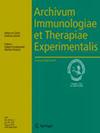Human Soluble TRAIL Secreted by Modified Lactococcus lactis Bacteria Promotes Tumor Growth in the Orthotopic Mouse Model of Colorectal Cancer
IF 3.9
4区 医学
Q3 IMMUNOLOGY
引用次数: 0
Abstract
Abstract Tumor necrosis factor-related apoptosis-inducing ligand (TRAIL) selectively induces apoptosis of sensitive cancer cells, including colorectal cancer (CRC). Due to its short biological half-life after intravenous administration and related clinical ineffectiveness, novel formulations of TRAIL need to be developed. Here we propose Lactococcus lactis bacteria as a vehicle for local delivery of human soluble TRAIL (hsTRAIL) in CRC. The use of common probiotics targeting guts as carriers for TRAIL could ensure its sustained release at the tumor site and extend the duration of its activity. We have already engineered hsTRAIL-secreting L.lactis bacteria and showed their effectiveness in elimination of human CRC cells in vitro and in vivo in a mouse subcutaneous model. Here, L.lactis(hsTRAIL+) were administered by gastric gavage to SCID mice with orthotopically developed HCT116 tumor in cecum, in monotherapy or in combination with metformin (MetF), already shown to enhance the hsTRAIL anti-tumor activity in subcutaneous CRC model. Oral administration of L.lactis(hsTRAIL+) resulted in significant progression of HCT116 tumors and shortening of the colon crypts. Secretion of hsTRAIL in the colon was accompanied by infiltration of the primary tumor with M2-macrophages, while MetF promoted transient colonization of the gut by L.lactis. Our study indicates that L.lactis bacteria after oral administration enable delivery of biologically active hsTRAIL to colon, however its potential therapeutic effect in CRC treatment is abolished by its pro-tumorigenic signalling, leading to the recruitment of M2-macrophages and tumor growth promotion.改良乳球菌分泌的人可溶性 TRAIL 促进结直肠癌正位小鼠模型中的肿瘤生长
摘要 肿瘤坏死因子相关凋亡诱导配体(TRAIL)可选择性地诱导包括结直肠癌(CRC)在内的敏感癌细胞凋亡。由于 TRAIL 静脉注射后生物半衰期短,临床疗效不佳,因此需要开发 TRAIL 的新型制剂。在此,我们建议将乳酸乳球菌作为一种载体,用于在 CRC 中局部给药人可溶性 TRAIL(hsTRAIL)。使用常见的肠道益生菌作为 TRAIL 的载体,可以确保 TRAIL 在肿瘤部位的持续释放,并延长其活性持续时间。我们已经设计出了分泌hsTRAIL的乳酸杆菌,并在体外和小鼠皮下模型中证明了它们在消除人类CRC细胞方面的有效性。在这里,通过灌胃给在盲肠正位培养出HCT116肿瘤的SCID小鼠服用乳酸杆菌(hsTRAIL+),可以单药治疗,也可以与二甲双胍(MetF)联合使用,二甲双胍在皮下CRC模型中已被证明能增强hsTRAIL的抗肿瘤活性。口服 L.lactis(hsTRAIL+)会导致 HCT116 肿瘤显著恶化和结肠隐窝缩短。结肠中hsTRAIL的分泌伴随着M2-巨噬细胞对原发肿瘤的浸润,而MetF促进了乳杆菌在肠道中的短暂定植。我们的研究表明,L.lactis细菌口服后可将具有生物活性的hsTRAIL输送到结肠,但其在治疗CRC方面的潜在疗效却因其促瘤信号而被取消,从而导致M2-巨噬细胞的招募和肿瘤生长的促进。
本文章由计算机程序翻译,如有差异,请以英文原文为准。
求助全文
约1分钟内获得全文
求助全文
来源期刊
CiteScore
5.90
自引率
0.00%
发文量
26
审稿时长
>12 weeks
期刊介绍:
Archivum Immunologiae et Therapiae Experimentalis (AITE), founded in 1953 by Ludwik Hirszfeld, is a bimonthly, multidisciplinary journal. It publishes reviews and full original papers dealing with immunology, experimental therapy, immunogenetics, transplantation, microbiology, immunochemistry and ethics in science.

 求助内容:
求助内容: 应助结果提醒方式:
应助结果提醒方式:


